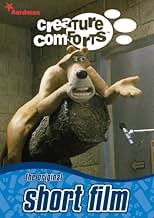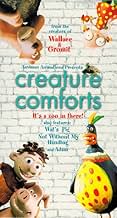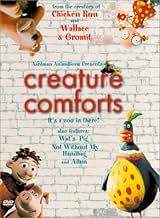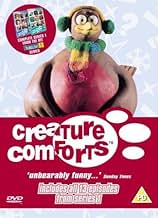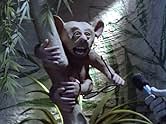NOTE IMDb
7,7/10
7,1 k
MA NOTE
Ajouter une intrigue dans votre langueA humourous and thought-provoking view of what animals in zoos might be thinking about their captivity and surroundings.A humourous and thought-provoking view of what animals in zoos might be thinking about their captivity and surroundings.A humourous and thought-provoking view of what animals in zoos might be thinking about their captivity and surroundings.
- Réalisation
- Scénario
- Casting principal
- Récompensé par 1 Oscar
- 6 victoires et 2 nominations au total
Avis à la une
I think this is my favourite Aardman animation and it's probably the simplest. The interviewer takes a delightfully comedic ping at the dreaded television "vox pop" by going to a zoo where she interviews an host of the occupants. Some are perfectly happy in their centrally heated, double glazed environment where they are fed and watered regularly, others - like the Brazilian lion need space, more space and then even more space. Oh, and water that he can can drink and swim in! The chickens steal the show for me, especially the two in the background who mimic the wave to the camera thing whist their pal is extolling the virtues of life in captivity. The dialogue entertainingly parodies the kind of nervously inane comments you get from the public when they are interviewed for the telly and it's genuinely funny. The stop motion clay-mation and the attention to the detailed depth of the characters and the scenarios as they relate their stories makes this a must watch.
10llltdesq
This short won the Oscar for Animated Short, beating another Aardman Studios short, A Grand Day Out. The concept behind its creation is an old one, used by John and Faith Hubley: record conversation and come up with fitting animation. In this case, someone went around interviewing residents of a housing development and the answers were transformed into the answers given to an interviewer by animals in a zoo. Everything here is excellent: animation, dialogue are wonderful. Most definitely worth getting. In print on more than one source: a compilation titled Creature Comforts and on The World's Greatest Animation. Highly recommended.
Before the "Wallace & Gromit" series and "Chicken Run", Nick Park made a splendid debut with "Creature Comforts", in which several animals in a zoo explain how unhappy they are to be in cages. If the cartoon is goofy, then they play it to good effect, and it has a good message. I've always thought that Nick Park not only has great ideas for cartoons, but that his claymation style is quite neat, with the bug eyes and rectangular mouths.
Other interesting cartoons of this style include not only the "Wallace & Gromit" series, but also "Wat's Pig" and "Ident". The last two are fascinating, if bizarre.
Other interesting cartoons of this style include not only the "Wallace & Gromit" series, but also "Wat's Pig" and "Ident". The last two are fascinating, if bizarre.
This is the old version of the soon-to-be TV series of Nick Park's Aardman Animations. Basically they record voices from real interviews talking about a certain subject, for example they mention about food and where they are living. When they have recorded these voices they use their genius to match this talking with a suitable character. All the characters are wild and zoo animals talking. There is a lion, tortoises, polar bears, a panda bear, a female gorilla, a hippo (with one behind her pooping) and many other animals made of the genius Plastercine. There is now quite a good TV series of this one-off show of interview made animation. The quality of this animation is obviously the fact that everything moving is made of Plastercine, it deserved the Oscar! As part of Aardman Animations, it was number 15 on The 100 Greatest Cartoons. Very good!
If there's any single short out there that marked a real defining point for those claymation whiz kids down at Aardman, I'd say 'Creature Comforts' is the one. The debut piece of the now legendary Nick Park (who'd go on to create a series of captivating short films featuring a certain cheese-loving inventor and his well-read canine cohort, whose names I'm sure you don't need me to spell out for you here), it's now a widely-regarded classic in stop motion animation history, and there are some pretty good reasons for that. No other Aardman project, great as they frequently are, has managed to combine such high levels of whimsy, charm and poignancy quite as deftly as this one. The bright idea of taking real-life recordings with members of the public and aligning them with talking plasticine animals in the style of vox pop interviews (in this case, zoo animals commenting on their general living conditions, as extracted from discussions with residents of retirement homes, council housing and student halls) was so fresh, so ingenious and so delightful that the five minute running time designated here simply wasn't enough. It was a concept which begged to be extended, and it spawned a much-deserved franchise in the early 90s with TV ads for the UK's Heat Electric and, more recently, a long-awaited TV series in 2003. A franchise which in turn helped to establish Aardman's now-firm reputation for colourful, offbeat cosiness, as opposed to some of the more downbeat and sombre shorts they'd been working on for much of the 80s (many of which were good enough in their own right - Peter Lord's 'Going Equipped', which debuted alongside 'Creature Comforts' in the Channel 4 series 'Lip Synch, in particular is more than worth a look).
Compared to a lot of the output that followed it, the animation here may look a little primitive by today's standards (the depressed gorilla, for example, is quite clearly riddled with the animator's finger prints), but it's an easily forgivable fault, and doesn't detract from the visual joy that this short is swimming in from start to finish. Get a load of all those wonderful sight gags - the elderly bush-baby's gigantic magnified pupils, the unidentified birds with beaks held on by elastic bands (the antics of the non-speaking characters hovering about in the background have always been something to keep an eye out for in the 'Creature Comforts' realm), the treadmill-running terrapins, the dozens of shrieking, flailing baby rodents all of it gold. Earning Nick Park an Oscar in 1990 for his efforts, it's endearing and comical to the bone - and yet there's also a mild tinge of sadness to it that I doubt 'Creature Comforts' would have been nearly as memorable without. For all the quirky cuteness that those clay-built critters possess, the anguish of a few of the original speakers remains persistent in their voices, and shines through in their pertaining characters quite dynamically. Most of the animals, it would seem, are perfectly contented with their lives in captivity, but there are a few who feel the sting of alienation, the homesick wild cat from Brazil being the standout personality on this one - the high range of exaggerated mannerisms that Park uses to bring him to life are unforgettable.
A lovely film and a wonderful concept, what makes 'Creature Comforts' such a striking experience is, in part, how it touches upon some of the helplessness and frustrations of having to live in a world you feel out of place in. It's also a whole lot of fun too.
Grade: A
Compared to a lot of the output that followed it, the animation here may look a little primitive by today's standards (the depressed gorilla, for example, is quite clearly riddled with the animator's finger prints), but it's an easily forgivable fault, and doesn't detract from the visual joy that this short is swimming in from start to finish. Get a load of all those wonderful sight gags - the elderly bush-baby's gigantic magnified pupils, the unidentified birds with beaks held on by elastic bands (the antics of the non-speaking characters hovering about in the background have always been something to keep an eye out for in the 'Creature Comforts' realm), the treadmill-running terrapins, the dozens of shrieking, flailing baby rodents all of it gold. Earning Nick Park an Oscar in 1990 for his efforts, it's endearing and comical to the bone - and yet there's also a mild tinge of sadness to it that I doubt 'Creature Comforts' would have been nearly as memorable without. For all the quirky cuteness that those clay-built critters possess, the anguish of a few of the original speakers remains persistent in their voices, and shines through in their pertaining characters quite dynamically. Most of the animals, it would seem, are perfectly contented with their lives in captivity, but there are a few who feel the sting of alienation, the homesick wild cat from Brazil being the standout personality on this one - the high range of exaggerated mannerisms that Park uses to bring him to life are unforgettable.
A lovely film and a wonderful concept, what makes 'Creature Comforts' such a striking experience is, in part, how it touches upon some of the helplessness and frustrations of having to live in a world you feel out of place in. It's also a whole lot of fun too.
Grade: A
Le saviez-vous
- GaffesWhen the Aye-Aye is being interviewed, the leaves around her keep randomly changing positions.
- Citations
The Brazilian Lion: In Brazil you have the space.
- ConnexionsFeatured in What's Up Doc?: Épisode #2.14 (1993)
Meilleurs choix
Connectez-vous pour évaluer et suivre la liste de favoris afin de recevoir des recommandations personnalisées
Détails
Contribuer à cette page
Suggérer une modification ou ajouter du contenu manquant

Lacune principale
By what name was L'avis des animaux (1989) officially released in Canada in English?
Répondre
